|
|

Sellers' Corner
Walter Shawlee 2, Kelowna, BC, Canada
The Slide Rule Universe
Everybody’s Wish List…..and Reviving the Dead
You have no doubt wondered just what people ask for when they call us at Sphere Research, looking for a slide rule. Aside from those of us that collect rules (and are therefore beyond therapeutic help), there are certainly some recurrent themes and requests from the “non-professional” slide rule aficionados out there. After initially being amazed that we have no complex and frustrating voice mail system, and that they can just call and talk to someone (because in fact, their call is actually important to us), here’s what they have to say:
- I want to find the rule I had in school. This is a very common request, and often is for a Post Versalog, K+E 4081-3 style, or Pickett log log style rule. However, we get just as many requests for very low end models, such as a Post 1447 or K+E 4053-3, because that’s what they happened to have used in school. Longing trumps all other issues for this person, and only just the right rule will do the trick.
- I want to get something to help my kids with their math, nothing they’ve tried seems to be working in school. This request comes to us from both parents and teachers, and really highlights the poor success kids are having when math agendas highlight set theory and bounding, and forgets all about calculating, exponents and estimating. You will be pleased to know that those who follow up with us later report good results when using even a simple rule as a teaching aid. Rules for this category are generally simple, and favorites have been the Pickett N902T (which carries its own manual on the rule body), and some Faber Castell rules like the 52/80 that can also do addition and subtraction.
- I just found your site, and I want a slide rule! This person is so excited by the idea that they can even get a slide rule today, they run all over the site, looking at every rule, and then get so confused, they can’t make up their minds. Once the heat has died down, and we have answered all 347 of their questions, they generally buy something very simple.
- I can finally afford it, and I want the rule I could never have when I was in school. These people have really thought about what they like and dislike, and are now ready to experiment with rules that weren’t common or available when they were in school. There’s no predicting what this person will buy, but it tends to be a more elegant and sophisticated rule, and often an import for the change of style and different features.
Meanwhile, what can YOU do with that unhappy rule in your collection that just doesn’t look very good? It may be a type that you really enjoy, and just wish was in much better shape. Well, first of all, don’t be afraid to clean it, since single makers told you to do so in their manual. Like any fine tool, it should be cleaned and adjusted for proper operation, simply because that is a firm requirement for the smooth and orderly operation of the universe, if for no other reason. Dirt is not really an antique “patina” that needs to be preserved for historical purposes.
My favorite weapons for restoring a rule are a scotch brite pad, a soft cloth, Windex, and several small straight screwdrivers (and a set of allen keys if I’m working on a K+E that requires it). I find Pledge (the spray furniture polish) is the ideal lubricant for guides and edges, and it also restores any exposed wood to a beautiful finish. You can see some very detailed restoration info at this page on our site: http://www.sphere.bc.ca/test/clean.html.
What to do about broken parts? There is no simple answer here, as the stocks of spare parts are almost gone from everybody’s stashes. I will often buy up bad rules on ebay to strip for parts, especially K+E and Dietzgen parts, which are wickedly hard to find, and prone to damage. There are some very sad looking rules out there that find their best and final moments as organ donors for a better rule. I have a few parts left (especially spare windows for the Pickett N3/N4/N16 rules), which you can find here: http://www.sphere.bc.ca/test/exchange.html.
Restoring old cases is not always successful, but you will find some very good tips on our site at the restoration link above. If nothing works, you can try to scour ebay for a usable case of the same type, or you might want to consider one of our new custom cases. I went crazy for years trying to restore cases with pen marks, initials, dymo tape, decals, cartoons, girlfriend’s phone numbers, and exam answers all over them. One day I just decided my life could be put to better use, and had new cases made by Seamcraft in the US, you can see all the details about them here: http://www.sphere.bc.ca/test/cases.html. The design is very flexible, and fits a huge range of rules, while providing a fully padded cushion case.
All for now,
Walter
walter2 “at” sphere.bc.ca
The Slide Rule Universe
|


|
The 'Other' Seller's Corner
Dick Rose, Columbus, Ohio
Vintage Instruments
You Do What for a Living???....How I Got Started
People are always incredulous when I tell them that I deal in slide rules -- that is, if they know what a slide rule is. Once past that issue, the inevitable question is: “How did you get into that??!!??” The question is particularly pertinent if the questioner knew me in my corporate and consulting days, when I was involved in marketing, marketing research, strategic planning, and organizational development.
Well, it all started with a mental health break while I was working on a consulting assignment. Tired of working on the computer, I decided to play a bit and went to eBay. While browsing there, I saw a Post Versalog that had sold for $30. “Interesting,” I thought.
I also took breaks from work by going to flea markets and antique shows. About a week after seeing the Versalog on eBay, I saw one at a flea market, for a dollar. “This might be fun,” I thought, and bought it. I went home and put the slide rule on eBay. A week later, it sold, for $30. It was fun.
After that, I looked for slide rules more purposefully and found some here and there. And I sold a few more. This was all for entertainment, since consulting provided a much better income (and still would, if I were in the mood).
Eventually I had put together a list of several hundred slide rules that I had accumulated. For some reason, I can’t remember why, Andrew Davie (the great father of online slide rule collecting and communication) asked me to send him a list of what I had. He then published the list on the Slide Rule Forum, and suddenly I was, accidentally, in the slide rule business. (Andrew, if you remember this differently, please comment.)
My list had no prices since it was really only an inventory list, so I started quoting prices on specific items when asked. And later, I decided to continue not putting prices on the list, mainly because it was a pain to change them when needed, which seemed to be often.
Around this time, I met Sandy, who was to become my wife not long thereafter. (I know a good thing when I find it.) There was only one problem. My younger son, Brian, was shortly going to be entering high school, and I wanted to stay with him until he graduated. And he and his mother, with whom I shared joint custody, lived in Kalamazoo, Michigan, as did I. But Sandy lived in Columbus, Ohio and had a business and many connections there.
A friend asked how we would manage all of that if we were to get married. I had to think fast, and, on the spot, I said, “Easy. For the next five years we will alternate between Kalamazoo and Columbus every two weeks, and Brian can live with us while we are in Kalamazoo. All we have to do is maintain our two houses, drive 300 miles every two weeks, and figure out how to earn a living while doing that.” It sounded so simple. (We were younger then.)
So we had it all figured out, except for the earning a living part. Sandy is a hardwoods lumber broker, and we worked out how she could operate in two cities. My consulting was a bit more of a problem, unless I wanted to be traveling constantly, which I didn’t. So I decided to make Vintage Instruments into a real business, with a web site, and began seriously searching for items to sell.
Walter Shawlee and I shared some large purchases, and I had helped him (only a little bit) when he decided to add slide rules to his electronics instruments web site. So I had a web site built. (Walter built his own. He’s far more talented in that area than am I.)
I had previously collected drafting tools and musical wind instruments so decided to add those, as well as mechanical calculators, planimeters, and other related items, to the Vintage Instruments business. I used the more general Vintage Instruments name to cover all of the instrument categories.
This all started in the late 1990’s, and here we are about ten years later. By the way, here is Columbus. We moved here full time when Brian graduated from high school. He is now a senior in mechanical engineering at Carnegie Mellon University. Smart fellow.
Being a part the slide rule community has had several interesting side benefits, not the least of which is that many of you have become my good friends. In fact, when Sandy and I married in early 2000, John Mosand (from Norway) and Gerhard Benedict and family (from Vienna) attended the wedding in Columbus. I had met both online, through their slide rule interests. And several of you have visited us here at home. One of the reasons that I love this business is the chance it has given me to meet so many interesting people.
And I hope to meet more of you, in person, at the February 23, Oughtred Society meeting in Las Vegas. Ted Hume suggested that it would be a good place for the two of us and our wives, Rose and Sandy, to finally get together. We will be there. How about you?
So, in summary, I got into the slide rule business because one day I needed a break while working and then I needed a way to manage a rather nomadic life. Strange, but true. And it has been a great time, thanks to you all.
See you in Vegas.
Dick Rose,
Vintage Instruments
|

|
Displaying a Collection
Clay Castleberry, Oroville, California
The shadow box is the ideal way to show off one’s collection of slide rules, or a part of it.
Bare rules hanging on the wall have a tendency to get dusty, and at least here in California, fall off the wall during earthquakes.
Glass cases are also ideal for display, if one has the space and the blessing of a partner for such expenditures.
The photos of the shadow boxes and the glass cases give good examples of best ways to show off your proud possessions.
Benefit from my experience in finding moderate prices for well made shadow boxes.
My first one (Fig. 1) is the 13 by 23 inch box with the fine collection of circular rules. I had hinted that it was what I would like as a Christmas Gift, from my wife of many happy Christmases. She had it custom made at a picture framing house for a sum that neither of us would like to disclose. It displays well but, changes displays badly, in that the backing must come off completely with each display change.
Later, I found the shadow box, (Fig. 2) which is now displaying a square and a round Gilson Atlas slide rule, at an antique shop for the grand sum of seven bucks. It is hinged with a hasp for securing it closed. It displays well and changes displays easily, by simply opening the hinged top.
Since our experience with the custom made shadow box, I have found reasonable priced shadow boxes, in the same picture framing studio, where we got our custom made box, and at stores such as Crate and Barrel. They are also reasonably available on EBAY, complete with other items that can be replaced with your favorite rules.
A display that is dust free helps make a happy home.
|

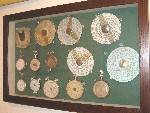
Fig. 1

Fig. 2
|
Favorite Items
Nathan Zeldes, Jerusalem, Israel
There are many items in my collection that I like… but if I had to choose, I’d say I have a soft spot for the homemade ones: items made or improvised by someone for their own use, or made and sold by them in small quantities; expressions of individual creativity so unlike the mass produced output of the IBM’s and Samsungs of today, or the K&E’s and Hemmis of yesteryear.
I have only a few such items, naturally; it calls for special serendipity to come across one in some flea market or online. The best without question is the mysterious hydrological slide rule I bought on eBay, because it caught my fancy the moment I saw its photo (Fig. 1).
This device is a roughly finished wooden slide rule covered with cellophane-coated paper scales. The scales are all meticulously drawn by hand in India Ink, and I mean meticulously: some of the lettering is incredibly small and precise. The rule was clearly made entirely by hand, but the attention to detail is exquisitely professional.
At first I had no idea what this item is all about. The scales (Fig. 2) have labels like rainfall, discharge index, run-off, impervious coefficients… it was obviously aimed at a specific profession, but what that profession was had remained a mystery. My eBay seller told me he had bought it in Holland from a guy who conjectured that it may have to do with crop spraying; for my part, I suspected rainwater management of some sort. And there the riddle remained for some time, until I discovered that Ron Manley, an experienced collector, is a Hydrologist! I sent him a photo and he identified the rule’s purpose as urban drainage design. The “impervious coefficients” are used to calculate what proportion of a drainage area is impermeable; hence labels such as “open spaces” and “residential-house density”, which refer to different types of urban development. The sub-scale (5, 6,...,14) refers to the number of houses per acre, so, for example, 10 houses per acre is equivalent to having 0.38 of the drainage area impermeable. The scales of Gradient and Velocity are used for sewer design; other scales calculate the water runoff for different conditions of rainstorm.
This is truly a unique calculating instrument; Ron had seen nothing like it before. Some hydrologist in the pre-electronic age of computation had designed a solution to his profession’s specific computing needs. I doubt I’ll ever find out why he went to all this trouble – did he build this tool for his own use? or perhaps this is a prototype he had built, in preparation for a commercial product that never came to be? Whatever his motive, his handiwork marks him as a person of knowledge, skill and the ability to improvise – in other words, a quintessential engineer. I know I would have enjoyed meeting this guy, but it is unlikely this will ever happen: I have no idea who he was. It is a common attribute of homemade devices that they don’t carry a maker’s name or logo; after all, their only user knows all too well who had built them!
Still, even if he will remain anonymous, I am honored that his one-of-a-kind product rests in my collection.
|

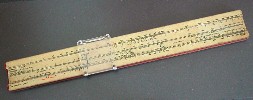
Fig. 1

Fig. 2
|
A Cabinet of Slide Rules
Otto E van Poelje, The Netherlands
Storage and display of one’s collection is an enduring topic of discussions and disagreements among collectors. In this contribution I would like to show here my own solution to the problem.
Because a problem it was, some 15 years ago when the collection had grown to over 200 items. We, as a family, decided that all my slide rule boxes – then scattered over several rooms - should be replaced by one single cabinet. This new repository was to meet a number of requirements – hopefully not too conflicting. It must have both a display area and a logical storage system with easy access, it should be able to contain some 500 slide rules, and it had to look nice.
A nice and almost antique dining room cabinet was found as starting base of the project. The top part of the cabinet, once used to display the nicer sets of porcelain or crystal, is now the showcase for cherished slide rules with special applications or designs. Behind both doors of the lower cupboard, the original single shelves have been replaced by a system of drawers that was specially designed to fit most slide rules, up to mid-size (25 cm scales). The four drawers between the two doors are used for other calculating instruments like mechanical and electronic calculators, dividers for use on Gunter rules, spare parts and incomplete rules for cannibalistic use, and redundant rules for swapping.
Display (See Fig. 1)
Behind the glass doors of the top part of the cabinet are not only displayed the highlights of the collection, the “conversation pieces”, but also the specimens that use all three dimensions of space, as opposed to regular, flat slide rules.
The granite desktop on the lower cupboard is an ideal parking space for “items under study”: an invitation to get on with the job.
Drawers (See Fig. 2)
Each drawer was made of a square frame of three wooden 1 by 1 cm sticks and a wooden front to hold brass knob and label holder, all this glued to a plywood bottom.
The inner dimensions of a drawer are 44 by 44 cm.
The usable height between two drawer bottoms is 2.7 cm. These sizes were based on extremes of length and case height of the monster Faber-Castell Novo Duplex. Of course the larger desk-sized rules, and especially the 2-feet Gunters, have a place outside the cabinet.
Storage of cases and boxes can be done in many ways: slide rule in the case, slide rule on top of the case (maybe with a rubber binder), slide rule next to the case or slide rule without the case (cases stored separately). Personally I like to see the faces of my slide rules as soon as I pull out a drawer, so the first option is not for me. Only nice or rare cases are allowed to join a slide rule in my drawer, I don’t want the wasted space of double height drawers, so option 2 is also not for me. The result is that only a few cases are stored in drawers, and the remainder has found a separate place, only linked to its slide rules by data base numbers.
All drawers are sliding along –again- 1 by 1 cm wood sticks which are affixed to the inner walls behind the doors. Drawers can be pulled out of the cabinet, to allow studying one or more drawers at leisure on a worktable.
In total 48 drawers are available behind the two doors of the lower cupboard, providing a storage area of more than 9 m2.
Arrangement (See Fig. 3)
In principle the drawers are organized and labeled alphabetically on brand name, from ALRO to Wolters-Noordhoff (Dutch brands both). Some brands need more than one drawer, like the six ones for Faber-Castell. But when there is not enough of a brand to fill a drawer, a “country” drawer has been created to hold more brands from that country. So at the lower right end of the cupboard there is a sequence of labels … UK – Unique – USA …, although K&E and Thornton have their separate drawers too.
Dynamic Collection Control (See Fig. 4)
Slide rules are laid out loose in the drawers, mostly in rows but sometimes at right angles to fill up unused space. This loose arrangement is a perfect fit to my dynamic collection control, because my collecting focus has changed considerably over the last 10 years.
The most shocking aspect of my cabinet is discovered by visitors when I tell them that the collection is not allowed to grow out of the cabinet. That means a maximum collection size of about 500 items - which has been reached by now. When I acquire a new item, an existing piece in my collection may have to go. Right!
I hope you will read more about such things in my article “on Collecting …” in the upcoming Journal of the Oughtred Society.
|

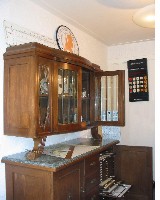
Fig. 1
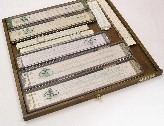
Fig. 2

Fig. 3
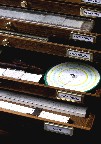
Fig. 4
|
Mystery of the Homemade Rules?
John Hunt Snr, United Kingdom
The first scan (Fig. 1) is a couple of slide rules that came into my possession two or three years ago. For me, they are an enigma.
The scales are paper pasted on wood. (Please see Fig. 2.) The stock and sliders are birch/pine and quick growing mahogany. Only one of the sliders has a tongue and groove. The cursors look like bashed-out coke or bean cans. The only thing, looking vaguely professional, are the scales. They have been laid out and drafted by a person with calligraphic training.
Hotchpotch of wood cobbled together to make the rules. (Please see Fig. 3.) On one of the rules, upper right, is an illegible name. Capt. C. J New?????
The subsequent scan (Fig. 4) compares scales with a typical Graphical Table from the Vietnam era. Range, Drift, Elevation, C (the change in elevation) are similar – obviously, my home-made rules are in fact crude Graphical Firing Tables.
But who would make a home made Graphical Table, given that the pukkah article could be picked up for peanuts? Anybody in an official position would almost certainly obtain one as part of the kit. I would guess that the War Department bought the mass produced product for little more than one dollar, if that – beaver board with varnished paper scales – not even the trailing edge of technology!
My contention is that my homemade rules were proto-types of the official Graphical Firing Tables that were mass produced and sent to campaigns from North Africa to Vietnam.
In November 1940, National Guard, Captain Abbott Harrington Burns was assigned to a Fire Direction Centre team in Fort Sill, Oklahoma. In response to the torture of solving complex equations with logarithmic and look-up tables he experimented with a homemade paper/cardboard slide rule. Most of his brother officers ridiculed the idea, but one major, George V. Keyser, saw possibilities with Burns’s Graphical Firing Table.
Working as a team they resolved the GFT problems and adapted it to compute time delays/powder charges and ranges for the 75mm and, subsequently, for the 105mm howitzer.
This was the easy part – much harder was the acceptance by the Army Council of their invention. The red tape was all enveloping and a depressed Burns was ready to give up. Keyser was not so intimidated, treading on well polished superior shoes he eventually sold the idea to the War Department.
Fig. 5 shows Brigadier General Desmond J. Balmer, Sill’s Field Artillery School Commandant, with Captain Burns - with the official GFT.
But, in the meantime, while the War Department was dithering, several officers in Fort Sill copied the GFT and found that they could dispense with 76 pages of fine type firing tables. And they could do it twenty times faster with less errors and even less hassle.
Somebody in Sill collared an expert draftsman bought him/her a beer and twisted his/her arm to draft the scales. The paper scales were distributed to forward looking officers, fed up with log tables, who cobbled up their own GFT with bits of wood and crude cursors. Young officers took them to Guadalcanal, Tunisia, Attu and Sicily before the War Department caught up with them in Italy and distributed the official GFT housed in a handsome leather case. All this is my supposition – correct me if you have contra knowledge or any other ideas.
The last photo (Fig. 6) is from the Signal Corps, near Sessa, Italy, taken on the 5th May, 1944. M/Sgt Rogers at the Horizontal Control Operators Firing Chart and Major Jackson is on the ‘phone. Spot the official GFT!
Burns ended up with the rank of Lt. Colonel and Keyser was the Brigadier commanding the 74th Field Artillery in Mississippi.
|


Fig. 1
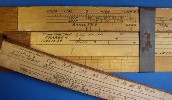
Fig. 2
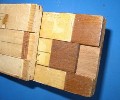
Fig. 3
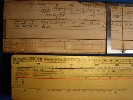
Fig. 4
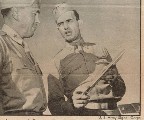
Fig. 5

Fig. 6
|
Buying and Selling Slide Rules and Related Items on eBay --
Experiences from Ten Years of Collecting
Louis J. Gotlib, West Chester, Pennsylvania
Over the past decade, the hobby of slide rule collecting has changed dramatically as a result of eBay, in the United States and elsewhere. The best thing about buying and selling via eBay is the diverse assortment of materials one can buy or sell in dealings with fellow hobbyists around the world. Since most, though not all, slide rules are relatively inexpensive (less than $50 for most items on eBay) there is little motivation for dishonesty in any form, as there is little to be gained, and in an environment where reputation (feedback score) is critical, there is much to be lost.
The one possible downside to eBay’s popularity is that our Oughtred Society meetings seem to have fewer items available for sale or trade. I do not know if this is the direct result of eBay sales of 400 to 500 items per week or more due to the nature of who is able to attend our meetings.
I have been involved with the hobby of slide rule collecting for over a decade and have been an active eBay buyer and seller for just about that long. My purchases have ranged from items that cost a few dollars to over one hundred dollars (though rarely much over that). As such, my comments will not necessarily apply to the high end of our hobby, although I do pay attention to those sales. My selling experience comes from selling of duplicates of some of my own items and from dealing with the collection of the late Aaron Lerner, wherein I sold several hundred items, most of which sold for between $25 and $150, which puts them in the “typical range” for eBay items and for what I think most collectors are looking to pay.
Selling hints:
Photos and accurate descriptions are crucial. eBay allows one free photo with each listing and it can be tempting to only use that one on an item likely to sell for only ten or twenty dollars. I recommend spending the extra money (about $0.15 per photo) and including an overall photo (showing the slide rule, case and box, manuals, etc.), followed by shots of the front and back at both ends. (Editor’s note: There are many free sources on the web for photo storage, including photobucket.com.) Make sure your photo shows the cursor (and be very clear about any damage to the cursor- especially with older K & E models). This may mean you spend a dollar to list an item that will likely sell for a nominal amount, but I am convinced that a good set of photos will bring in extra bidders, get a higher price and will also let other bidders know that you handle all items in a professional manner (and the more expensive your items are the more important that reputation is).
My experience has been that timing your sales to end on a Sunday evening at about 9:00 Eastern Time allows bidders across the entire United States to be more likely to be online at closing time. I try to avoid having items end on holiday weekends as there will be fewer people online at the end of the auction. I have no “proof” of this but at least it seems logical. eBay lets you create the listing and set a scheduled start time which is very convenient. It does cost $0.10 for this feature but the convenience is worth it.
Make sure your description is accurate and includes any flaws, no matter how minor you think they may be. It is better in the long run for you to err on the side of caution and get a slightly lower price than to gloss over something that will lead to an unhappy buyer.
I strongly recommend setting up a PayPal account for accepting payments. It is true that it will cost about 3% of each sale price and the shipping costs but you will have almost no personal checks to worry about, no issues with currency exchange and payments will be in your account promptly. You can have PayPal electronically send money from your account to a checking account of your choice at no charge and you will also be able to use your PayPal balance to pay for your own eBay purchases with vendors who accept PayPal. Between PayPal and eBay fees you will be spending about 8-12% of the sale price of each item, but this will make transactions smoother.
Do not try to make a profit on shipping costs, but don’t lose money either. The Postal Service provides free Priority Mail boxes that will fit most slide rules and you can use newspaper as packing material for most items. I like to wrap items in a clean sheet of newsprint first as this minimizes any chance of ink rubbing from the newspaper onto a slide rule. My usual approach (shipping from the east coast) is to determine the weight the packed item will have, look up the cost of shipping to the west coast (or go to a self-service scale at the post office and enter any west coast zip code). I then put in a shipping cost of the Postal Service price rounded up to the next dollar. I find that this way I cover my costs but don’t take advantage of people. I do not have a “handling” charge as this is just padding the price. Sometimes I misjudge and lose a dollar or two on the shipping but in the long run I come out pretty close to even. I offer and recommend insurance, based on Postal Service rates if requested but don’t require it. I use the same approach with tracking.
Overseas shipping can be a bit trickier. I have found many inconsistencies between the USPS web site and their own offices. Despite recent efforts to clearly define a package vs. a letter I have gotten surprises at the post office when I went to mail a box. Sometimes I have taken a loss of as much as $10 on the item (once I quote a shipping price to the winning bidder I feel I should honor it). On a few other occasions I have found that I charged much too much (the postal clerk decided that box could be a letter!) and what I usually do is refund the difference back to the buyer via his or her PayPal account.
If a buyer is unhappy with a purchase, try as hard as you can to work things out. Accurate descriptions and clear photos usually keep problems from happening but should an item be damaged on the way and there is the chance it was poorly packed, try to reach a compromise with the buyer. In my sales of over 400 items I have had two buyers who were not happy. In one case the item was fine but I wrote the zip code wrong so the item was late. All I could do was apologize to the buyer. In the other case I was selling a folding rule from an estate and since I was outside my area of expertise my description failed to point out a flaw that mattered a great deal to the buyer. When told of the problem I simply asked the buyer what would make him happy. He asked that I refund $25 of the $50 final price, which I did immediately via PayPal. I really have no idea if that was fair or not but it was his area of expertise and it seemed reasonable.
Make sure you leave feedback promptly for buyers who pay promptly. For new eBayers, being able to establish a good feedback rating is very important. For established buyers it may be slightly less critical but it is still helpful. It takes just a few seconds to put “positive feedback” and short phrase such as “very prompt payment, thanks.”
Buying Hints:
My first rule is buy things that I want to have in my collection. Thanks to Rod Lovett’s great site (http://sliderules.lovett.com), it is fairly easy to find what a reasonable price for most items should be. The site is limited by the key words in the title so it is not perfect but by researching selling prices for a model, one can get a good estimate to a reasonable range. Since most sellers overestimate the quality of a slide rule, one must be a bit cautious. I will hardly ever bid on an item that has no pictures (though I will ask the seller for some) as that leaves too much to chance. If you think you are interested in an item, place it in your watch list and ask the seller detailed and specific questions. Make sure you give him or her a few days to get back to you.
Don’t buy an item because you think it will be something you can resell at a profit. It might well be, but on eBay there are no certainties. If you want it, place a serious bid and watch it closely.
I do not use “sniping” services although many people do and they find them very valuable and worth any fees. My feeling is that if I want something I will know what I am willing to pay for it and I will enter that bid. If I am outbid, another will likely come up soon (there are about 400-450 slide rules on ebay at any one time in the United States alone.) You can easily get “sucked in” and bid more than you really intended on an item. As much fun as this hobby is, it is just a hobby after all.
There are a few other things that will keep me from bidding on an item. I will not bid on an item if I think the shipping costs are unreasonable. This can be difficult to judge for items from overseas but within the United States it is quite easy. Sometimes I will ask the seller if his listed shipping cost is correct or if another method might be available at lower cost. I have seen many people ask a $14 shipping fee for a slide rule that weighs a few ounces and can go in a (free) Priority Mail box for less than half that amount.
In summary, eBay has given us a chance to add to our collections in ways were not available in the past. I find that, as is the case with most dealings, communication and honesty go a long way. Bid with enthusiasm when you want something, but know what you are willing to pay and stick to it. If you are unhappy with a transaction, communicate with the other person. He or she may not even know you were unhappy and while most collectors are bright people, few are psychic.
|

|
Non-Collectors’ Corner
Ted Hume, San Angelo, Texas
What does one do if he or she no longer collects slide rules or other instruments, but remains interested in them?
I am one of those people, who once collected and researched Post slide rules very seriously. This led to collaboration with Paul Ross to compile the Post Slide Rule Archive, which can be seen at Walter Shawlee’s website Slide Rule Universe, http://www.sphere.bc.ca/test/sruniverse.html
I once had 150 Versalogs, plus another 100 Post rules. My collection now consists of 6 slide rules … a small handful of favorite Posts.
What do I do?
For several years I have been active in the Oughtred Society, doing work on various projects and activities ...
One does not need to be an active collector in order to contribute and benefit from Oughtred Society membership and participation in the world of slide rules and other calculating instruments!
|

|
|
| |
|
|